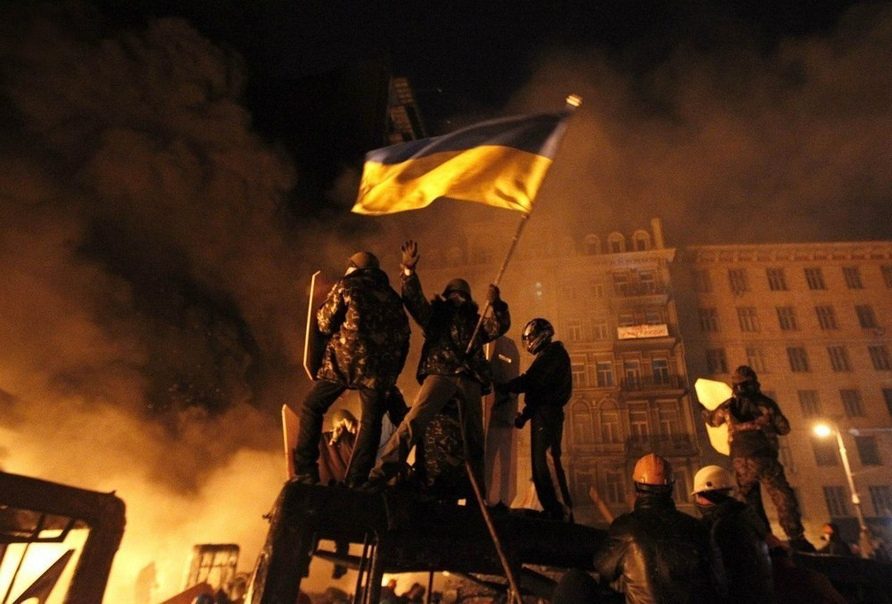Ukraine on Fire presents a likely controversial overview of Ukraine’s political history leading up to the 2014 protests in Euromaidan and shedding light on today’s military developments in Eastern Europe.
Directed by Igor Lopatonok and produced by Oscar winner Oliver Stone, the 2016 documentary defies the mainstream media narrative on the geopolitical analysis of the Russia-Ukraine conflict, spanning events from the World War II to the Cold War. The film features the international pressure over Ukraine — leading to an apparent coup d’état ousting the democratically elected Viktor Yanukovich and culminates with the implications of NATO expansion.
In the documentary, Oliver Stone uses his critical lens on the Ukraine crisis, and more specifically on the role played by the US. Labelled as propaganda by the Western media, Russia’s argument of “denazifying” Ukraine as a justification for the invasion is analysed in Ukraine on Fire with the spotlight on a number of neo-nazis groups that, over time, seemed to have incorporated the Ukrainian National Guard.
1. Ukrainian Nazis joining forces with Hitler
In a throwback to World War II, the documentary denounces the estimated 80,000 Ukrainian ultra-nationalists — notorious for their cruelty towards the Polish, the Jewish and Russian people — who have joined the Schutzstaffel, the infamous Nazi SS.
In 1929, the Organization of Ukrainian Nationalists (OUN) was founded by Stefan Bandera, an ardent nationalist known by the CIA for leading a “reign of terror” and masterminding several ethnic cleansing operations, such as the 1941 Babi Yar massacre, where nearly 34,000 Jews were killed. However, after the war, Bandera fled to Europe, backed by the CIA for safe entry.
2. Cold War
“The CIA’s fingerprints can be found throughout the conflict,” the film stated, referring to the aftermath of the protests in Ukraine, both the 2004 and 2014 revolutions and events dating back to the Cold War. According to the documentary, CIA documents declassified in 2016 reveal strong ties between US intelligence and Ukrainian nationalists since 1946.
Such ties would serve as a possible source of counter-intelligence against the Soviet Union. During the Cold War, Ukrainian nationalists were part of numerous military operations, including Operation Belladona, Operation Lynx, and Operation Trident.
Yet, during the Nuremberg trials in 1945-1956, Ukrainian Nazis were spared from proper justice. “By 1951, the Agency [CIA] excused the illegal activities of OUN’s security branch in the name of Cold War necessity,” reads a declassified memo from the CIA.
The Ukrainian ultra-nationalist movement kept growing with names like Dmytro Dontsov, Andriy Melnyk and Roman Shukhevych shaping the neo-Nazi movement. In 1989, the Ukrainian nationalist organisation Narodny Rukh (People’s Movement) was created, serving as an incubator for neo-Nazi leaders against the Soviet Union’s trajectory towards the West guided by Mikhail Gorbachev’s Perestroika and Glasnost policies.
Shortly before the end of the Soviet Union, in 1991, Oleh Tyahnybok founded yet another nationalist group, Svoboda, which ideology was the purging of Jews and ethnic Russians in Ukraine. As early as 2012, the BBC reported the danger of Ukraine’s ultra-nationalists, particularly Svoboda, and the EU passed a resolution condemning the group as anti-Semitic and xenophobic.
3. US ties with Svoboda
Despite the warnings from Europe, Victoria Nuland from the US State Department met Tyahnybok, Svoboda’s leader, in February 2014, ahead of the Euromaidan protests. The plot thickens when Nuland was caught on tape with the US Ambassador to Ukraine, Geoffrey Pyatt, masterminding an apparent coup d’état. “Now it would be great to help glue this thing and have the UN help glue it and, you know, f*ck the EU,” said Nuland.
Recalling his troubled tenure as a President (2010-2014), Viktor Yanukovich told Oliver Stone: “My high-level contact was VP Joe Biden. We had frequent phone conversations but the problem was that Mr Biden said one thing but they did different things in Ukraine.”
As for Mr Pyatt, the US Ambassador, Yanukovich said he received visits from Maidan representatives all the time. “We got the impression that the headquarters in charge of the whole process was in the US embassy,” said Yanukovich.
4. EU and IMF pressure
Throwing back to 2013, Yanukovich explained that Ukraine was going through a difficult economic period and the country was torn between turning to the EU, the International Monetary Fund (IMF), or Russia. With an existing trade agreement with Russia, Yanukovich sought to negotiate a new — and better — agreement, but both the EU and the IMF offered “unacceptable solutions”, he said.
“A significant rise in utility rates, for electricity and natural gas. This would mean a lot more expenses for the people, while their income would stay at the same level,” said Yanukovich about the IMF’s proposal. Ukraine suggested other solutions, but these were officially rejected by the IMF in November 2013.
Kyiv was left with Russia, which said it was ready for partnership if their interests were taken into account. Interviewed by Oliver Stone, the Russian President Vladimir Putin said that an agreement with Ukraine “would mean that EU goods would enter the Russian market without any negotiations”, which was not tolerated by the EU.
Talking about the trade agreement proposed by the EU, Yanukovich said that Ukraine couldn’t go ahead because it “required essential economic expenses and Europe didn’t provide any loss balancing.”
5. Euromaidan
After Ukraine’s decision to move towards the East for trade partnerships, the documentary reveals the manufacturing of a protest, with Euromaidan right behind the corner. As the November 2013 protest started in Ukraine, three new TV channels went on the air and suddenly became stunningly popular. Spilno TV was launched on November 21, Hromadske TV went live on November 22 and Expresso TV followed on November 24. These channels went viral supporting the protests, which were asking for an alignment with the EU and encouraging more and more people to go to Maidan.
Eventually, the protests led to overthrowing the President Yanukovich after an apparent coordinated action between the US and Ukrainian nationalist groups. Such outcome was reported by the filmmaker as the result of a successful staged revolution which included “money, the media and techniques”.
6. NATO expansion
A crucial element featured in the documentary is NATO’s military threat bordering the Russian Federation. NATO has not stopped expanding since the fall of the Soviet Union, growing from 17 countries in 1990 to 30 today, several of which were once part of the Soviet-led Warsaw pact.
“Why do we react so vehemently to NATO’s expansion?” asked Putin. “We are concerned with the decision-making process. I know how decisions are made. As soon as the country becomes a member of NATO, it can’t resist the pressure of the USA.”
Putin stressed the military threat that NATO membership poses to Russia, saying that “anything at all can appear in such country such as missile defense systems, new bases, or, if necessary, new missile strike systems.”
Putin’s lack of sense of security has been compared to the Cuban missile crisis in 1962, when the US drew a red line in respect of the installation of medium-range missiles 70 km from its border and the world was at the brink of nuclear war.
“This is a very dangerous topic. It’s a topic of war. War between the US and Russia would be complete madness,” said Yanukovich referring to NATO expansion.
Described by critics as Russian propaganda, Oliver Stone’s Ukraine on Fire 2016 documentary presents verifiable claims that bring a different perspective when reflecting on the military escalation in Ukraine and have recently been voiced by the US political scientist John Mearsheimer.













